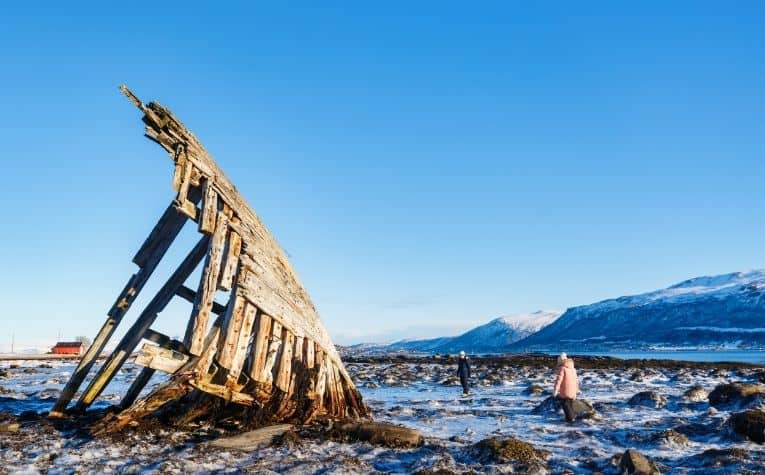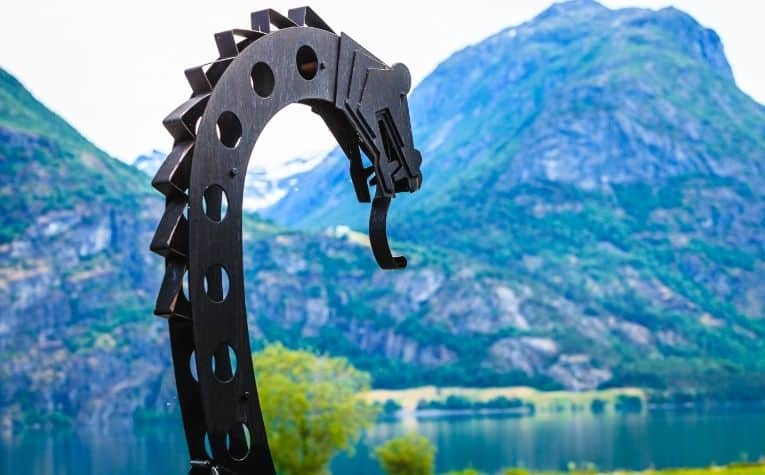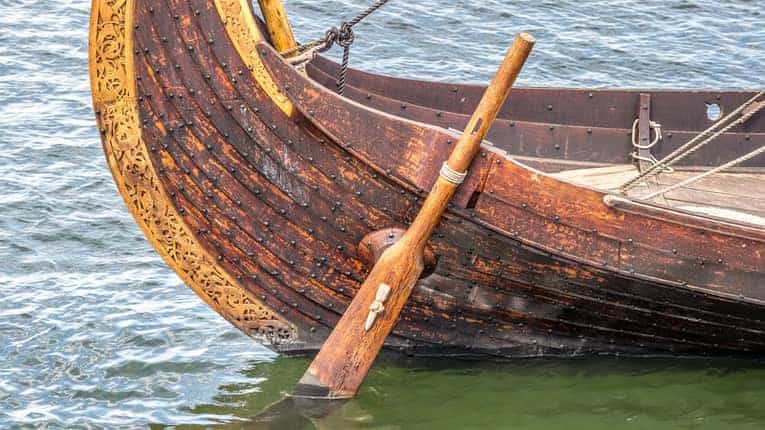The Vikings were a seafaring society whose ability to utilize oceans and waterways to transport themselves and goods for trade was unrivaled for two and half centuries.
Key to their dominance was the iconic Viking longship with its signature sleek profile and shallow draft.
On rare occasions, Vikings did burn their ships to pay special tribute to prominent members of their community as part of their burial practices.
Archaeological evidence shows only a few instances of such ceremonies and launching ships out to sea and setting them ablaze most likely never happened.
Life during the Middle Ages was full of hardship, and this was certainly true for the Vikings.
Their deeply held belief in the afterlife is believed to have contributed to the ferocity and fearlessness with which Viking warriors went into battle, for should they meet their demise, an eternity in Valhalla awaited them.
And as in life, the important roles played by ships when Vikings died cannot be understated.
The Vikings had a purpose for everything they did. See Here’s why Vikings used longboats to learn more.

Did Vikings Burn their Ships? Here are the Facts
Much of what is now known about the Vikings results from painstaking research and physical evidence recovered by way of archaeological excavations.
The Vikings were not in the habit of documenting their triumphs or their exploits, even when it came to perhaps their crowning achievement from an engineering perspective, the emblematic longship.
Fortunately, through the years, several incredible finds have revealed not only the methods by which Viking ships were built but also the materials that were used and the purposes they served.
Just as importantly, archaeologists and historians have been able to shed light on just how important ships were to the Vikings.
Not only did the Vikings rely on their ships to conquer, trade, and explore, their beloved ships carried them on the most important journey of all: from the realm of the living to their final destination in the afterlife.
A lot of people know that the Vikings raided the English, but did they ever fight the Romans? See Did the Vikings Ever Fight the Romans? to learn more.
The Myklebust – Proof the Vikings Burned Ships

In 1874, on a farm in Norway, a large burial mound was discovered, and upon excavation, the remains of what turned out to be the largest Viking ship ever excavated on Norwegian soil were found.
The Myklebust ship, as it came to be known, was believed to have measured over 98 feet (30 meters) in length and 21 feet (6.5 meters) in width.
Scientists determined that the Myklebust ship was burned as part of an elaborate funeral ceremony for a prominent Viking leader, theorized by scholars to have been King Audbjorn of the Fjords (he is mentioned in Norse sagas).
An enormous bed of ashes, along with rivets (to bind wood planks together), and metal shield bosses, were carefully analyzed to calculate the ship’s impressive dimensions.
The burning of ships as part of cremation ceremonies was not uncommon in Norway during the 8th and 9th centuries.
It is widely believed that the Myklebust ship was not only the largest ship to have been burned during the Viking Age, but quite possibly, the last. [1]
Did the Vikings ever fight people groups from the East? See Did the Vikings Ever Fight Samurai? to learn more.
Ships were Burned in the Norse Sagas
The notion of burning ships was glorified in Norse sagas, particularly in the tale of Baldur’s tragic death and the elaborate funeral ceremony that was held in his honor.
The tragic victim of Loki’s trickery, Baldur was the Norse god of light, son of the all-father Odin and the goddess Frigg, and half-brother to the almighty Thor, the god of thunder.
Baldur’s body was laid on the deck of his majestic ship Hringhorni with his belongings surrounding him.
His widow Nanna was so overcome with grief that she died of heartbreak, and her body was placed next to Baldur’s.
The entire vessel had been transformed into a funeral pyre of epic proportions.
So large and heavily laden was Baldur’s ship that after many failed attempts by the Norse gods to get it unstuck from the sand, the giantess Hyrrokken was summoned to launch the ship out to sea.
Once afloat, the mighty ship was set ablaze, and it sailed off into the horizon. [2]
Burning Ships out at Sea Probably did not Happen

On occasion, Vikings transformed ships into lavish funeral pyres and burned them as an extraordinary way of honoring their dead.
As far as launching them from shore and shooting flaming arrows from afar to ignite them, it is a near certainty that burning ships at sea in this or any other manner (including the various ways that Hollywood depicts these events) did not happen.
Cremation played a major role in Viking funeral practices, especially before the Norse people were introduced to Christianity.
It was believed that the smoke from the intense flames carried the deceased’s spirit away to the afterlife.
Once the body was reduced to bones and ashes, they would often be placed in an urn and buried along with the dead person’s personal effects. [2]
The reality of cremation is that an incredible amount of sustained heat is required to reduce a body to ash properly.
As far as the minimum temperature for cremation, roughly 2,000° F (1,093° C) is required, and as far as time, a minimum of two hours is needed.
And this is under suitable circumstances on land; on open water, it is difficult to fathom achieving the right conditions needed to cremate a body properly. [4]
Ships were as Important in Death as in Life
To the Vikings, ships were not just vessels that enabled them to travel over water. They also served to transport their dead to the afterlife safely.
For this reason, many Viking burial mounds feature large rocks and boulders placed on the ground in such a way as to form the recognizable outline of ships.
Prominent members of Viking society, such as chieftains, warlords, or people of wealth and influence, would even be buried in their ships along with important personal effects including:
- Weapons in the case of warriors
- Valuables, including jewelry, fine clothing, and even animals like horses
- In some instances, slaves were sacrificed and buried along with their masters [4]
Some of the most historic Viking finds recovered by archeologists are ships that were buried with their powerful owners, namely:
- The Gokstad Ship – discovered in 1879 near Oslo, Norway, the Gokstad ship was immaculately preserved and measured over 78 feet (24 meters) long and 16 feet (5 meters) wide. Buried with the ship was a man estimated to be in his 50’s whose remains revealed significant battle wounds.
Fine clothing and linens were found in the grave, suggesting he was a person of importance.
His grave goods likely included weapons and jewelry at the burial, but the assumption is that robbers made away with them centuries ago. [6]
- The Oseberg Ship – in 1903, a Norwegian farmer clearing his land came across a burial mound that later revealed a well-preserved vessel that came to be known as the Oseberg ship. Two women’s remains were found within the ship, along with an impressive array of items, including a cart, sleighs, textiles, and the remains of horses, oxen, and dogs.
This grave had also been robbed, but the items that had been left behind still suggest that the Oseberg women were very distinguished members of their community. [7]
Viking Ships Required Great Resources to Build
There were perhaps no more valuable community assets for the Vikings as a people than their iconic longships.
These vessels transported warriors to and from raids that yielded great riches and valuables and ferried goods and cargo along the many trade routes the Vikings had established with trade partners throughout Europe and as far away as the Middle East.
Viking ships were constructed using the clinker method, which entailed laying down and riveting together overlapping wood planks to form the hull, then building the frame from within the vessel. (Also see The Viking Shield: The Meaning of Their Shape, Color, and Patterns)
Because the Vikings used simple tools like axes, mallets, and wedges to harvest wood from oak or pine trees and build their longships, shipbuilding was a laborious and time-consuming process.
Based on what is known today about the materials and methods employed by the Vikings to construct their longships, it has been estimated that a 30-meter (98 feet) vessel required:
- 28,000 hours of labor would have been necessary from start to finish
- Depending on the number of workers available, a boat this size could have taken approximately six months to complete
- 14 large oak trees (minimum three feet in diameter) would have been needed to supply the wood with special care taken when cutting them down so as not to break any branches
- Other materials would have included iron rivets, pine tar, and animal hair, to name a few
Considering all of this suggests that an incredible amount of resources went into building a single Viking ship.
While the wealthy and powerful upper classes could certainly afford the cost of shipbuilding and ultimately being buried in one, the decision to ablaze such a valuable asset would not have been taken lightly under any circumstance. [8]
Conclusion
Although it rarely happened, if a Viking ship were burned in recognition of someone, it would have been a tremendous honor indeed.
References:
[1] fjordnorway.com
[2] norse-mythology.org
[3] History.com
[4] Life in Norway
[5] Ancient Origins
[6] thevintagenews.com
[7] history.co.uk
[8] regia.org
